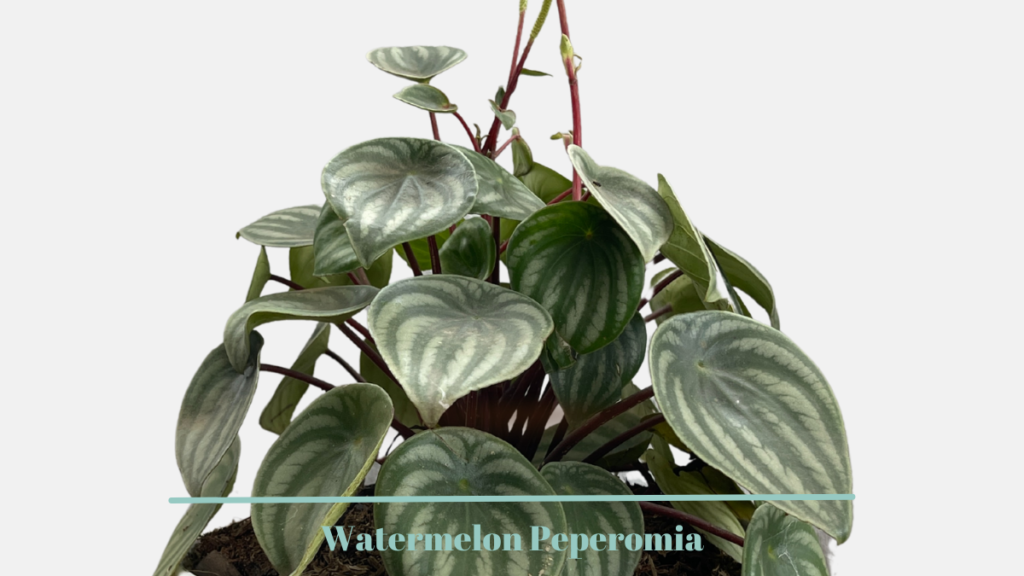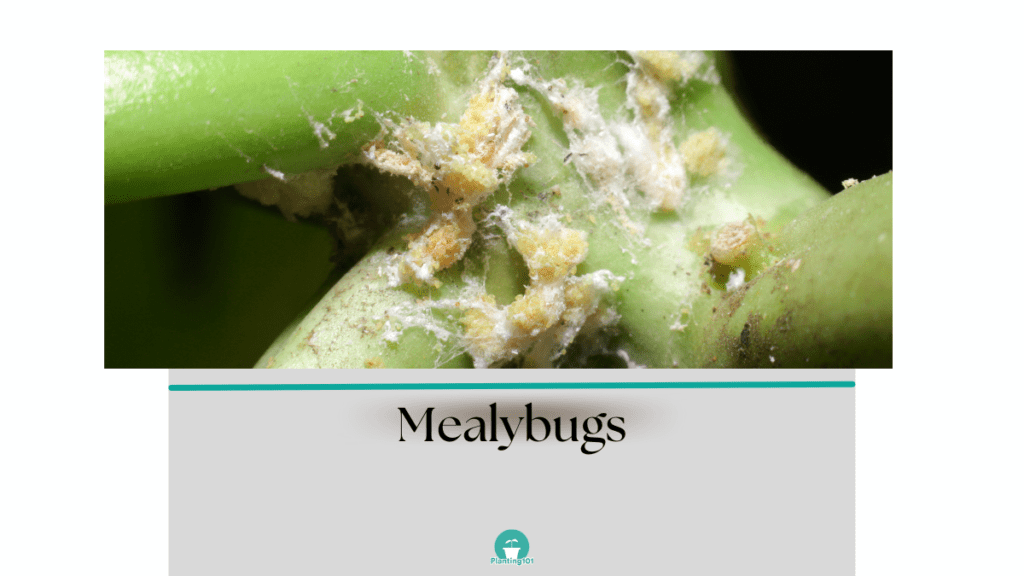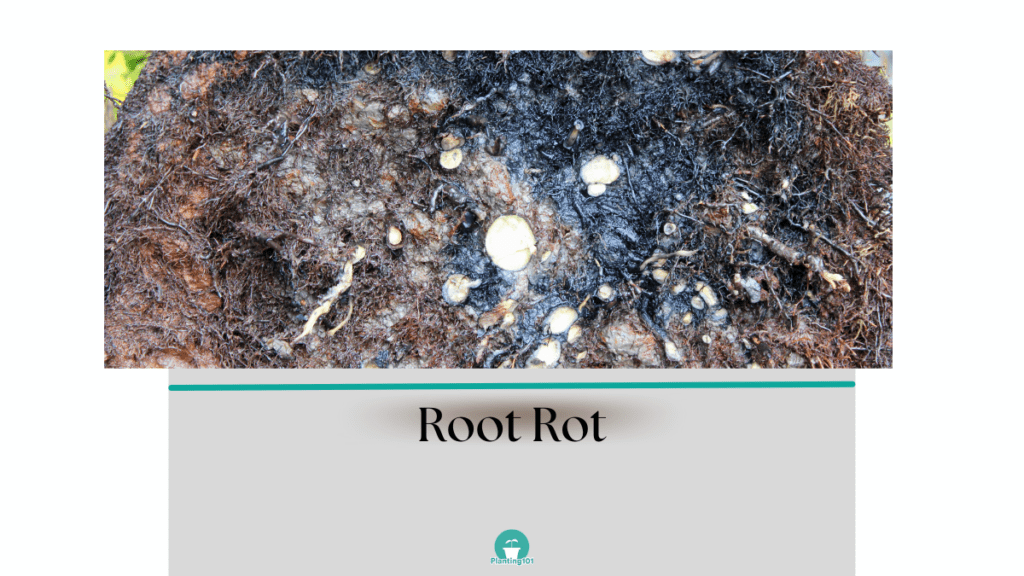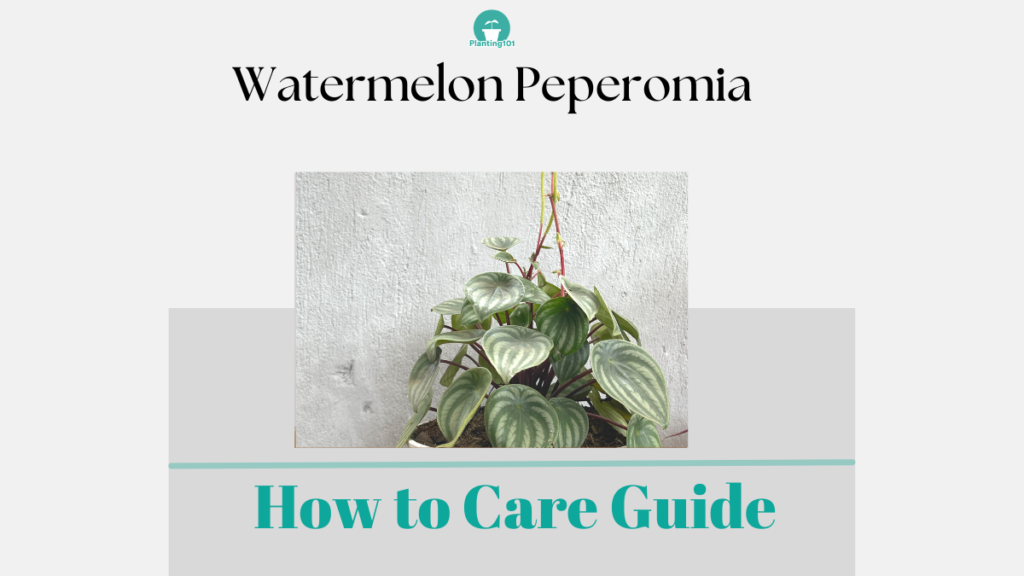Watermelon Peperomia (Peperomia argyreia) is a small houseplant with beautiful cream and green foliage that is reminiscent of watermelon rinds. Similar to other peperomia varieties, it can tolerate low light conditions and will grow well under artificial light. Watermelon Peperomia will grow well on an office desk or bookshelf. It is also a humid-loving tropical plant that will do well in bathrooms. Here is a beginner’s guide on how to care for your Watermelon Peperomia indoors.

Watermelon Peperomia Houseplant Care at a Glance
| Name | Watermelon Peperomia |
| Scientific Name | Peperomia argyreia |
| Light | Bright Filtered Light. Can Tolerate Low Light. |
| Daytime Temperature | 70 to 80 F (21-26C) |
| Night Time Temperature | 60 to 70 F (15-21C) |
| Water | Abundant Water |
| Humidity | High Humidity |
| Potting | Well-draining, organic, all-purpose potting mix |
| Fertilizer | Once every 2 weeks at half strength during the growing season. Once a month in the winter. |
| Toxic to Pets and Humans | Non-Toxic |
Watermelon Peperomia: Common Names
Watermelon Peperomia is also called Watermelon Plant, Watermelon Begonia, and Peperomia sandersii.
Watermelon Peperomia: Size
Your Watermelon Peperomia is a small houseplant that grows to less than 12 inches tall and wide.
Watermelon Peperomia: Toxic to Dogs?
According to the ASPCA, Watermelon Peperomia is not toxic to dogs. However, you may want to keep your Watermelon Peperomia out of reach if you find your dog snacking on it frequently!
Watermelon Peperomia: Toxic to Cats?
According to the ASPCA, Watermelon Peperomia is not toxic to cats.
Light
Watermelon Peperomia: Sun or Shade?
Watermelon Peperomia grows best in bright, filtered light in an East facing window. It will also grow well in a north-facing window since it is tolerant of low light conditions. Watermelon Peperomia also does well under artificial light, making it ideal in offices and home offices.
Water
How Often Should You Water Your Watermelon Peperomia?
Your Watermelon Peperomia likes moisture. Water your Watermelon Peperomia when the soil feels dry. The best way to tell when it is time to water your Watermelon Peperomia is to feel the soil. Stick your finger in the soil 0.5 inches deep. If it feels dry, it’s time to water your Watermelon Peperomia.
What Type of Water Should You Use When Watering Your Watermelon Peperomia?
Your Watermelon Peperomia can be watered with tap water but be mindful of the water temperature that you are using to water your Watermelon Peperomia. Don’t use straight cold water from the tap to water your Watermelon Peperomia.
Watermelon Peperomia prefers cool water that is not hot and not cold. When you turn on the cold water from the faucet add a little bit of warm water. You can also get to this ideal temperature by filling a watering can or pitcher with water and leaving it out overnight until the water is at room temperature.
How Do You Make Sure There is Proper Drainage for Your Watermelon Peperomia?
Your Watermelon Peperomia Good drainage is important, you don’t want your Watermelon Peperomia to sit in soggy soil. Make sure there are drainage holes at the bottom of the pot. After watering your Watermelon Peperomia and you see water draining out of the pot’s drainage holes, make sure you empty out the accumulated water in the saucer. Don’t let your Watermelon Peperomia’s pot sit in this puddle of water. It will cause root rot!
Do You Need to Mist Your Watermelon Peperomia?
Your Watermelon Peperomia is a tropical houseplant that likes humid conditions. You should increase indoor humidity. Turn on the humidifier. Mist your Watermelon Peperomia a few times a week. Keep your Watermelon Peperomia in your bathroom, it will happily grow in a humid bathroom environment.
Soil
What Type of Potting Mix is Best for Your Watermelon Peperomia?
Your Watermelon Peperomia needs a well-draining, organic all-purpose potting mix.
How Do You Know When To Repot Your Watermelon Peperomia?
Repot your Watermelon Peperomia when it outgrows its current pot. Repot your Watermelon Peperomia in a container with a diameter 2 inches larger than the current pot. Keep your Watermelon Peperomia in small containers since these are small plants.
Fertilizer
Do You Need to Fertilize Your Watermelon Peperomia?
Your Watermelon Peperomia should be fertilized once every 2 weeks at half strength during the growing season. Once a month in the winter.
What Fertilizer Should You Use on Your Watermelon Peperomia?
Use liquid or powder, organic fertilizer with a higher ratio of nitrogen on your Watermelon Peperomia.
Propagation
How Do You Propagate Your Watermelon Peperomia?
Your Watermelon Peperomia is easy to propagate. You can propagate your Watermelon Peperomia by stem tip cutting. Below are steps on how to propagate Watermelon Peperomia by stem tip cutting:
1. Take a Stem Tip Cutting of Your Watermelon Peperomia (include a node)
Pick a stem with a node. Cut below the node.
2. Place Your Watermelon Peperomia Stem in a Jar of Water
Place the Watermelon Peperomia stem into a jar of water and wait for it to grow roots. To help it focus its energy on growing roots, make sure your stem has a maximum of 2 leaves. Cut off extra leaves as needed.
Another way to stimulate root growth is to dip your stem cutting in root hormone and plant it in moist sand. I personally prefer the jar method so you can easily see the roots come out. Know that not all stem cuttings of Watermelon Peperomia will grow roots, so to be safe, cut a few stem cuttings so you will at least get one with roots.
3. Plant Watermelon Peperomia Stem Cutting in a New Pot
Once the roots grow, plant these stem cuttings into a new pot. Water the new plant immediately after planting. Then water every 2-3 days until the roots are established.
4. Place your New Watermelon Peperomia in a Spot with Bright Indirect Sun
Place your new Watermelon Peperomia plant in a spot with bright indirect sunlight. Don’t put it in direct sunlight.
Common Problems of Watermelon Peperomia Plant Care
The most common problems that affect Watermelon Peperomia are root rot, edema, and mealy bugs.
Watermelon Peperomia Problem: Fluffy White Growth In Between the Leaves and Stems of your Watermelon Peperomia
Problem: There are fluffy white growths in between the leaves and stems of your Watermelon Peperomia.

Cause: Mealybugs are causing the fluffy white growth on your Watermelon Peperomia. It is a common houseplant disease.
Solution: To get rid of mealybugs on your Watermelon Peperomia, wash your plant with water. You can also use soapy water. Spraying rubbing alcohol on affected areas can also get rid of mealybugs. Horticultural oil and insecticidal soap are also effective in getting rid of mealybugs.
Check out our article on how to make your own homemade pesticides using baby shampoo: How to Make Horticultural Oil and How to Make Insecticidal Soap
Watermelon Peperomia Problem: Your Watermelon Peperomia Looks Wilted (Soil is Wet)
Problem: Your Watermelon Peperomia looks wilted even if the soil is wet. Check for root rot by pulling the plant out and examining the roots. If the roots of your Watermelon Peperomia plant look mushy (healthy roots are firm) and the roots are gray to black in color, these are telltale signs of root rot.

Cause: Root rot is caused by fungus and is a serious problem for your Watermelon Peperomia. Root rot is a result of wet soil due to overwatering or poor drainage.
Solution: When your Watermelon Peperomia is afflicted with root rot the chance of survival is slim. Your best course of action is to throw your Watermelon Peperomia out and start over with a new plant. This time don’t overwater your Watermelon Peperomia and make sure there is good drainage in the pot.
Watermelon Peperomia Problem: There are Small Brown Bumps on the Leaves of Your Watermelon Peperomia
Problem: There are many small brown bumps on the leaves of your Watermelon Peperomia. These brown bumps can’t be picked off the leaves.
Cause: Your Watermelon Peperomia has developed Edema. These small brown bumps are growth on the leaves that is a result of overwatering.
Solution: Reduce watering frequency on your Watermelon Peperomia. Make sure there is sufficient drainage so your Watermelon Peperomia does not sit on soggy soil.
Cleaning Watermelon Peperomia Houseplant
What’s the best way to clean the leaves of your Watermelon Peperomia?
Dust accumulates on your Watermelon Peperomia leaves over time. The layer of dust decreases the plant’s ability to photosynthesize. Periodically wiping down the leaves of your Watermelon Peperomia with a damp cloth will help keep your plant healthy. You can also use a duster or dry duster cloth to wipe off the layer of dust on leaves.
You May Also Be Interested In:
How to Take Care of Haworthia (infograph)

